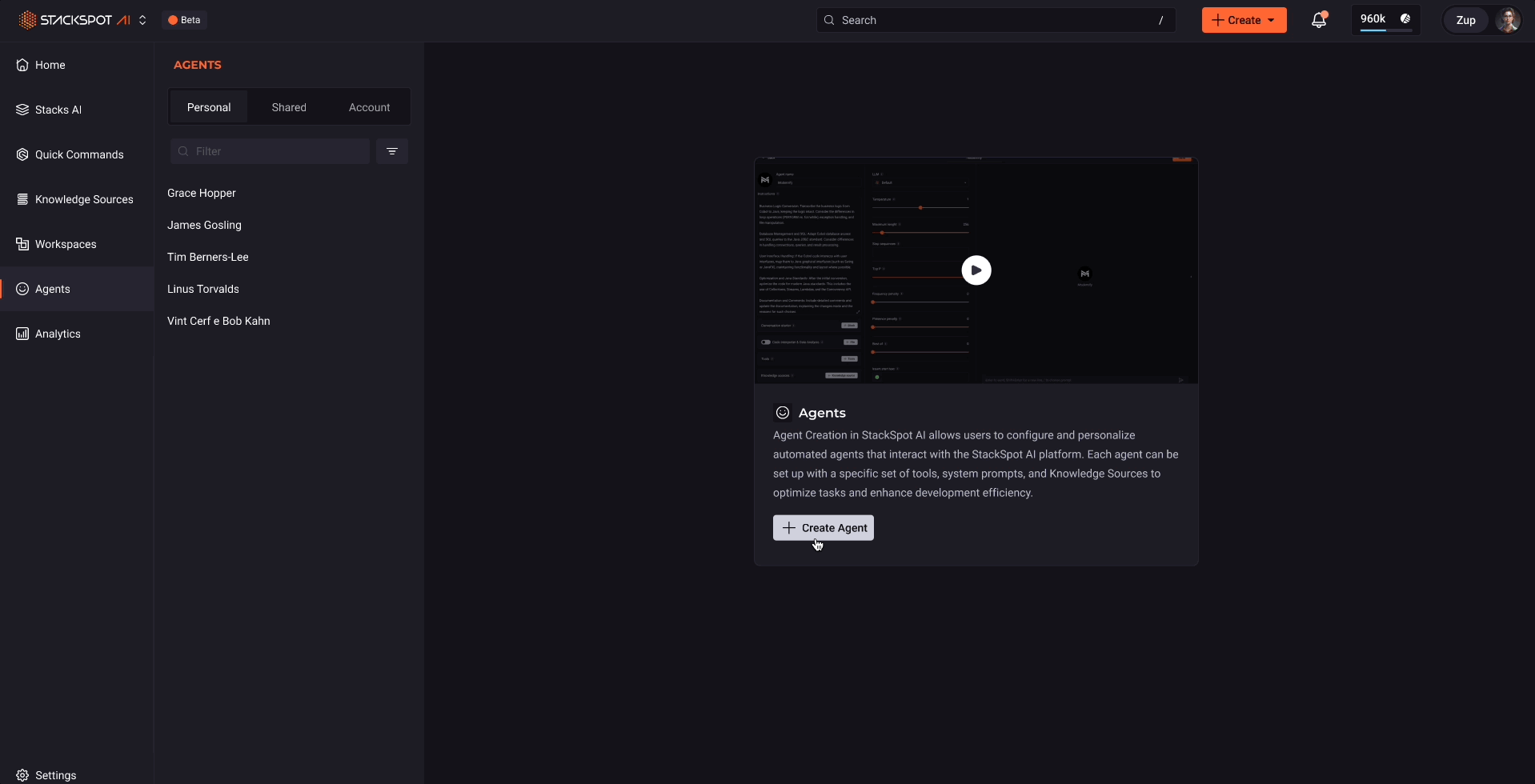Press reports and market trends in recent years have regularly covered the potential of Artificial Intelligence (AI), particularly generative AI. As a result, AI solutions are proliferating, prompting organizations to explore how to get the most out of this emerging technology. One approach is adopting the right tool, such as StackSpot AI.
Unlike other solutions, StackSpot AI leverages context, knowledge bases, and technological decisions to deliver precise, high-quality suggestions.
This article delves into the impact of StackSpot AI. Discover the unique features, major benefits, and practical use cases you can explore today!
What is StackSpot AI?
StackSpot AI is a multi-agent platform designed for the entire software development cycle. Its contextualized AI integrates generative AI models, offering project-specific responses and quick commands to automate repetitive tasks.
StackSpot AI fosters effective collaboration among all players in the software development cycle, building a robust ecosystem of knowledge and tools.
Our approach boosts productivity while driving the creation of innovative software solutions. From modernizing legacy systems implementing new design patterns to managing the entire development process, StackSpot AI sets the standard for delivering the fastest, highest-quality code across the development cycle.
Check out the StackSpot AI documentation for additional information.
The power of contextualization
Contextualization enables Artificial Intelligence to understand and learn from your code, style, stack, structures, documentation, and much more. You can incorporate market standards, industry norms, and business rules to ensure the AI’s suggestions align more closely with your business priorities.
As a result, the suggestions provided by a contextualized AI tool will be more assertive, boosting your team’s productivity by avoiding generic answers or even hallucinations.
Beyond contextualization in the current project… Companies are far more complex than a single project, requiring deeper contextualization to achieve more relevant suggestions—something that StackSpot excels at.
And we can’t talk about the effectiveness of an Artificial Intelligence tool without talking about Prompt Engineering. To get the best answers, you must ask well-structured questions, provide feedback to the AI (such as evaluating responses in StackSpot AI) and even develop a library of prompts (more on this in Quick Commands).
StackSpot AI’s main features
Discover what makes StackSpot AI the ultimate solution for boosting productivity across teams working in the software development lifecycle.
Knowledge Sources
StackSpot AI leverages Large Language Models (LLMs) to learn your code preferences and needs. One key feature is Knowledge Sources, which you or your team can upload to the platform.
A wide range of materials can serve as Knowledge Sources, including groups of code snippets, APIs, and documents in formats such as PDF and TXT.
By using Workspace with the documents you create, you give StackSpot AI enough information to direct its responses to the context and requirements of your team or project.
Moreover, the more Knowledge Sources you add and reference in your prompts, the more precise the suggestions become.
Want tips for setting up assertive Knowledge Sources? Check out this article on the StackSpot blog.
Quick Commands
Quick Commands are predefined actions that allow you to send quick information to the LLM. StackSpot AI assists developers with complex actions while automating repetitive or low-value tasks.
The built-in Quick Command offers five predefined functions that are ready to enhance your coding:
- Add tests for this code
- Document this code
- Explain the code to me
- Is there any code smell in this code?
- Refactor this code
Customized Quick Commands can also be created. This feature is easy to set up, with nearly limitless possibilities. Simply define the actions, select the Knowledge Sources, assign the agent for each step of your Quick Command, write prompts for each step, and you’re all set!
They are easy to use and can be accessed by right-clicking or typing “/” in the chat.
Artificial Intelligence Agents
AI agents are automated systems powered by Artificial Intelligence to perform specific tasks and make decisions based on preloaded information. In StackSpot AI, these agents are fully customizable and can be tailored to your project’s specific needs.
Essentially, AI Agents act as virtual experts, automating processes and improving efficiency throughout the software development cycle.
Gartner predicts that by 2028, AI agents will autonomously handle at least 15% of daily workplace decisions, compared to 0% in 2024. AI Agents are first on Gartner’s list of the Top 10 Strategic Technology Trends for 2025.
StackSpot AI Agents can perform a variety of tasks to optimize the software development cycle, including:
- Code reviews
- Converting product requirements into detailed, actionable user stories
- Analyzing code to suggest documentation

Main benefits of StackSpot AI
StackSpot AI can do a lot for your company’s software development lifecycle. Here are the main benefits of the solution:
Compliance with standards and good practices
StackSpot AI ensures that your staff will adhere to the rules and best practices you have defined, including the standards and methodologies established by the company. By streamlining code generation, it simplifies code maintenance, structural consistency, team onboarding, etc.
Enhanced productivity
StackSpot AI boosts productivity by enabling engineers to deliver more high-quality code in less time. For other people involved in the development process, contextualized suggestions tailored to the project’s specific needs will make all the difference.
Error prevention
StackSpot AI includes configurable features to increase code security (more on this below). By leveraging your context, the tool’s suggestions align with your security standards and prevent professionals from bringing in vulnerable snippets.
Improved Developer Experience
StackSpot AI offers a simpler and more efficient developer experience by streamlining complex tasks, automating routine processes, and providing assertive responses that increase dev productivity.
StackSpot AI use cases
Launched in November 2023, StackSpot AI offers a range of use cases that can significantly enhance various tasks within the software development cycle. Here are some examples:
Quality
- How to write complete unit tests faster
- How to speed up acceptance test automation
- Automating web tests to validate accessibility with Robot Framework
- How to run automated Rest API tests
- Test-Driven Development (TDD) and prompt engineering
- Facilitating the creation and review of Behavior-Driven Development (BBDs)
Security
- How to detect code vulnerabilities and apply automatic fixes
- Improving security with script standardization and automation
Product Management
- Refinement of intelligent backlogs and optimization of user stories:
- Initial detailing of features by Product Managers
- Refining and distributing tasks
- Quick Command with user story templates
- Quick Command to define clear acceptance criteria
Important: This tutorial already has an AI Agent; follow it on our YouTube channel.
Documentation
Conclusion
StackSpot AI is a great way to leverage Artificial Intelligence to your advantage. It offers assertive responses and multiple paths to enhance productivity in the software development lifecycle.
From planning and design to code generation, testing, and deployment, StackSpot AI’s multi-agent platform covers the entire software development lifecycle, ensuring every phase benefits from intelligent automation and contextual insights.
The benefits are even more significant when it comes to code creation. AI-driven development means higher coding quality, consistency, productivity, and more. By improving the value-added output of your code, this tool helps elevate your organization to the next level.
StackSpot AI enables developers and companies to accelerate software development by improving quality and efficiency, reducing cognitive load, and streamlining processes.
Explore StackSpot AI, reach out today, and learn about the possibilities.

 Skip to content
Skip to content


